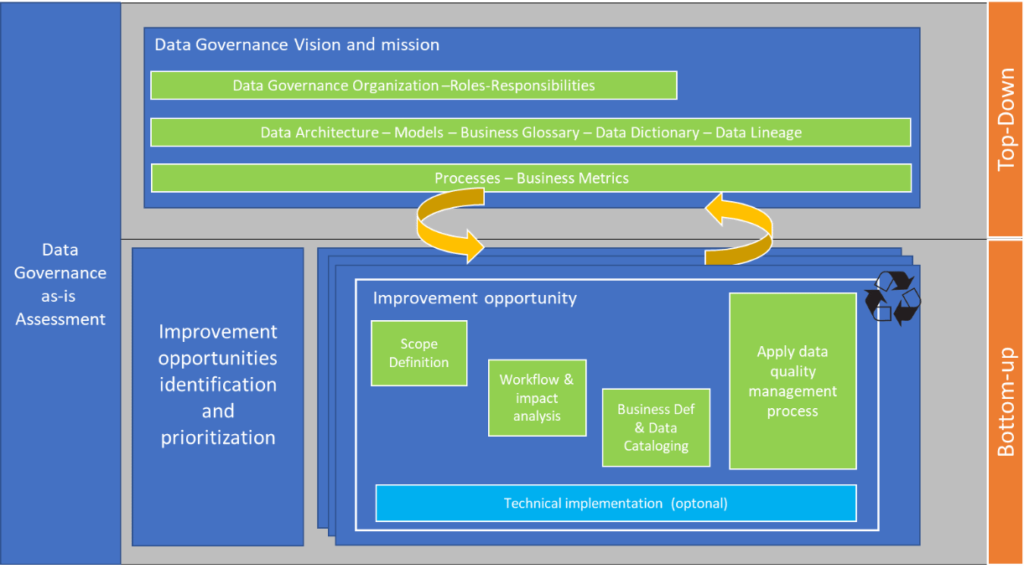In this series of articles, we will discuss the various strategies that can be used to implement data governance. After having listed the reasons for which setting up data governance is important in the previous chapter, this next section describes the Top-Down and Bottom-Up approaches in detail. To conclude, we will look at a hybrid approach combining the advantages of the two.

The so-called “Top-Down” approach
When this approach is used, it usually means that the decision to set up data governance comes from company heads, at quite a senior level. The approach then consists of general principles that describe senior management’s final vision as regards the form that data governance should take. It is often accompanied by various guidelines that constitute a transformation plan, and includes the names of people appointed as responsible for data within the company.
When using this type of approach, data governance is often perceived or understood as being an additional and independent initiative from already identified projects.
Advantages of the “Top Down” approach
This approach has the following advantages:
- Data governance helps the company develop a long-term vision that will guide decision-making during transformation.
- It implies top management sponsorship of the transformation initiative, which is in itself a key success factor.
- It implies the development of a business case, and hence provides a powerful lever for change.
- Since a business case, has, at least implicitly, been prepared, the link between data governance and business stakes has been clearly established. This also constitutes an important lever that will justify changes and speed up transformation, as well as the implementation of data governance.
- As the vision is defined and communicated by top management, it is not easily challenged. This facilitates teams’ involvement in the transformation by reducing political conflicts between them due to differing visions.
Drawbacks of the “Top down” approach
However, the drawbacks of the “Top down” approach are very real:
- In the short term, top management’s decision to initiate the set-up of data governance offers no added value to field teams and may even be seen more as a disturbance or an additional constraint than an urgent need. The risk then is that this may dampen teams’ support for the change, or even cause outright resistance to change reactions.
- Such an approach to change can conflict with other business projects already under way as well as teams’ routine activities. This can limit their ability to implement them and could also cause resistance to change reactions.
- Similarly, organising the implementation of such a plan can be vague at best, hence leaving the burden of practical organization of the transformation plan to middle management who were not necessarily involved in its development and whose objectives may not be compatible with the plan.
- Since the set-up of data governance requires thousands of practical changes of all kinds, it is virtually impossible for top management to monitor its evolution and to efficiently oversee the implementation. As a result, the transformation is managed in a somewhat detached manner, and the risk of failure is higher.
The so-called “Bottom-Up” approach
Its starting point is usually the installation of a new tool and it is fundamentally different from the “Top-Down” approach. It involves capitalizing on solutions developed to solve data management problems encountered by field teams to set up data governance, by trying to render changes made durable and generally applicable.
Benefits of the Bottom-up approach
The Bottom-up approach has clear benefits:
- The most obvious and important benefit of this approach is that it helps focus transformation efforts on elements that will improve day-to-day activities in practical ways.
- The Bottom-Up approach also helps optimise the prioritisation of changes to implement since it combines activity performance improvement, thanks to better data quality, with data management improvement itself.
- Initiating change at field level facilitates risk identification and taking into consideration difficulties and obstacles that constitute the constraints of the existing ecosystem. There is, for example, less risk involved in starting to modify business processes when you possess knowledge that is practical and first-hand rather than distant and theoretical.
- Since it is based on the existing system, this approach helps avoid embarking on mammoth transformation projects and break down data governance implementation into smaller-size, manageable projects, with clearly-defined scopes and clearly identified benefits.
Drawbacks of the “Bottom-up” approach
Unfortunately, the Bottom-up approach suffers from the following drawbacks:
- In the absence of top management’s vision and strong commitment, the influence of middle management on teams other than theirs – but whose involvement is required to ensure transformation success – could be too limited. A scenario which is quite frequent in real life and that considerably increases the risk of failure of the company’s transformation process required to set up data governance.
- The lack of an unsiloed, global, comprehensive and shared vision within the company means that the various transformative actions taken in the field do not fall within a common framework. A fact that increases the risk of inconsistencies in the approach, and limits the chances of success of the company’s digital transformation.
- By placing the responsibility of initiating change management projects on field teams, the organisation may lose sight of the expected impacts of data governance implementation. In such cases, it is likely that since there is no global business case for the company, the justifications and objectives of initiated projects obscure the big picture. Departments could even make choices that would favour them in the short term but turn out to be detrimental to the company as a whole.
Top-Down/Bottom-Up approaches: combining the best of both worlds
As seen above, both approaches have their advantages and their drawbacks. And neither seems to offer an ideal solution to help efficiently set up data governance within a company. However, one may wonder whether it is absolutely necessary, or relevant, to choose one approach over the other. The company opting for a combination instead, could acquire the best of both worlds whilst managing to avoid most of their respective drawbacks.
In practical terms, a combination of the Top-Down and Bottom-Up approaches would take the form of a two-way transformation:
- The “Top-Down” approach would ensure the forging of a top management validated and sponsored company vision as regards the data governance mission and the identification of its required features, thereby helping everyone understand the challenges posed by such a transformation.
- The “Bottom-Up” approach would ensure an agile and iterative implementation that complies with a defined framework. It would focus on identified and limited opportunities for improvement, whilst taking into account field constraints such as existing processes, limited resources or the obligation to ensure business continuity, whilst attempting to capitalise both on commitment to improvement and the opportunity to make changes that will add value in the short term.
Mutual and permanent adjustments in the Data Governance Board
For such a system to work, it is obvious that the two constituent parts of the transformation must “communicate”. A clear vision helps define a framework and generate opportunities for improvement onsite. But implementation insights also provide information that helps sharpen and clarify the defined vision, if necessary. It is within the “Data Governance Board”, acting tool of the Chief Data Officer, that these mutual and permanent adjustments between the two branches that make up the selected approach will have to take place.

As is the case in navigation, where setting a course is not enough to reach a destination, the ability to adapt to circumstances is essential in this type of project. Successful data governance implementation not only requires a clear vision of the objective to reach, but also the ability to efficiently and continuously adjust the transformation approach by taking into consideration field constraints.
















Your email address is only used by Business & Decision, the controller, to process your request and to send any Business & Decision communication related to your request only. Learn more about managing your data and your rights.